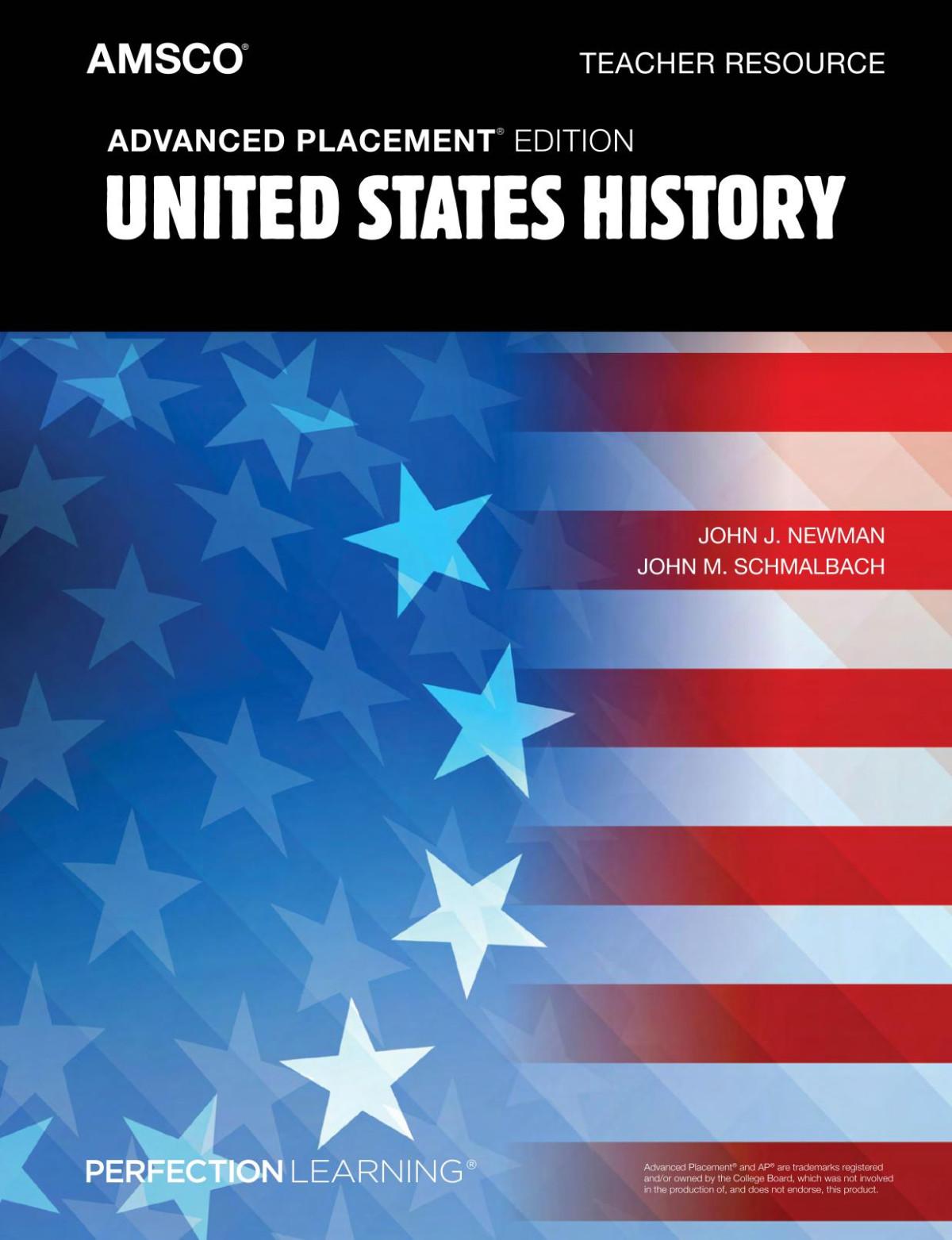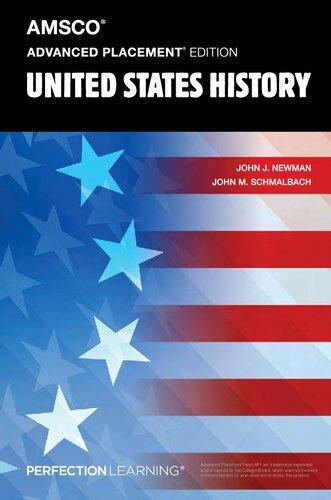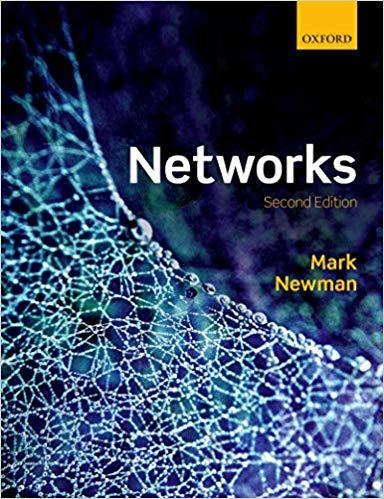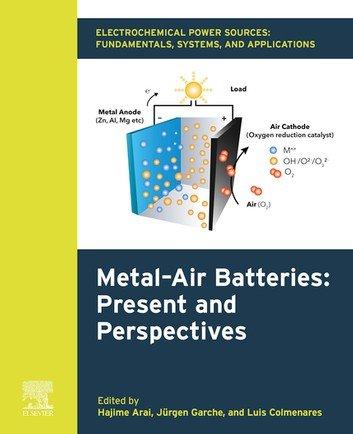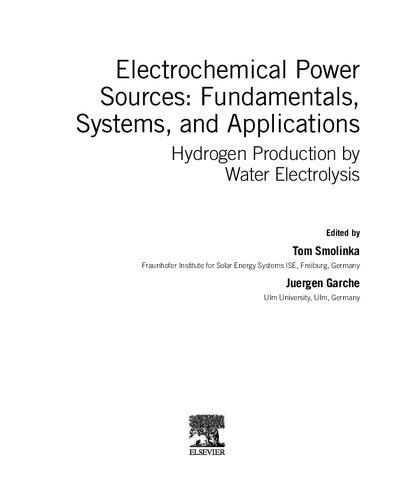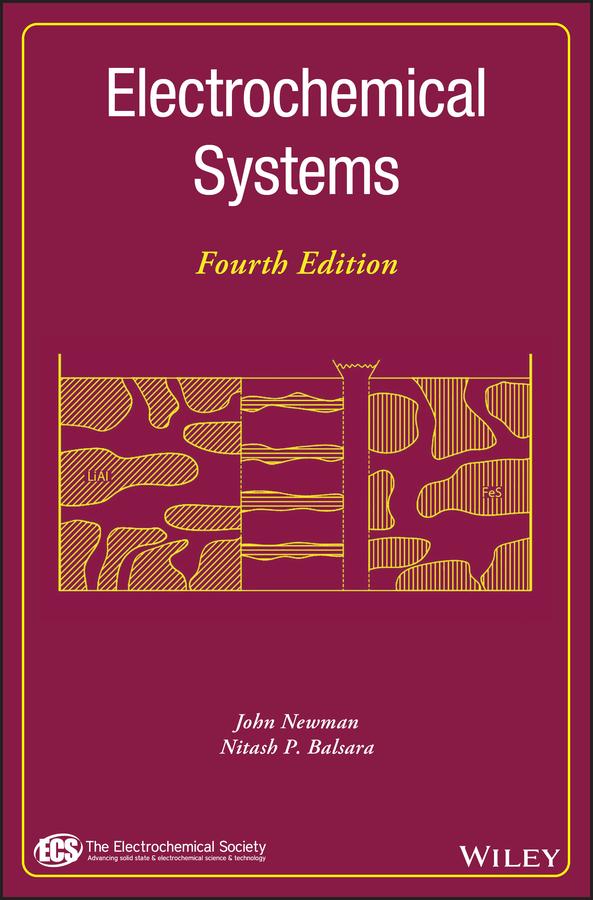Electrochemical Systems Fourth Edition John Newman Visit to download the full and correct content document: https://ebookmass.com/product/electrochemical-systems-fourth-edition-john-newman/
More products digital (pdf, epub, mobi) instant download maybe you interests ...
Electrochemical Power Sources: Fundamentals, Systems, and Applications Tom Smolinka
https://ebookmass.com/product/electrochemical-power-sourcesfundamentals-systems-and-applications-tom-smolinka/ United States History (Teacher Resource) 4th Edition
John J. Newman
https://ebookmass.com/product/united-states-history-teacherresource-4th-edition-john-j-newman/
Sociology: A Global Introduction, Fourth adaptation ed. Fourth Adaptation Edition John J. Macionis
https://ebookmass.com/product/sociology-a-global-introductionfourth-adaptation-ed-fourth-adaptation-edition-john-j-macionis/
AMSCO® Advanced Placement® United States History, 4th Edition John J Newman
https://ebookmass.com/product/amsco-advanced-placement-unitedstates-history-4th-edition-john-j-newman/
Networks (Second Edition) Mark Newman
https://ebookmass.com/product/networks-second-edition-marknewman/
Electrochemical Power Sources: Fundamentals, Systems, and Applications: Metal-Air Batteries: Present and Perspectives Hajime Arai
https://ebookmass.com/product/electrochemical-power-sourcesfundamentals-systems-and-applications-metal-air-batteriespresent-and-perspectives-hajime-arai/
John Henry Newman and the English Sensibility: Distant Scene Jacob Phillips (Editor)
https://ebookmass.com/product/john-henry-newman-and-the-englishsensibility-distant-scene-jacob-phillips-editor/
Electrochemical power sources: fundamentals, systems, and applications : hydrogen production by water electrolysis / 1st Edition Edited By Tom Smolinka
https://ebookmass.com/product/electrochemical-power-sourcesfundamentals-systems-and-applications-hydrogen-production-bywater-electrolysis-1st-edition-edited-by-tom-smolinka/
Lighting for digital video and television Fourth Edition John Jackman
https://ebookmass.com/product/lighting-for-digital-video-andtelevision-fourth-edition-john-jackman/
ELECTROCHEMICAL SYSTEMS THEELECTROCHEMICALSOCIETYSERIES TheElectronMicroprobe
EditedbyT.D.McKinley,K.F.J.Heinrich,andD.B.Wittry
ChemicalPhysicsofIonicSolutions
EditedbyB.E.ConwayandR.G.Barradas
High-TemperatureMaterialsandTechnology
EditedbyIvorE.CampbellandEdwinM.Sherwood
AlkalineStorageBatteries
S.UnoFalkandAlvinJ.Salkind
ThePrimaryBattery(inTwoVolumes) VolumeI
EditedbyGeorgeW.HeiseandN.CoreyCahoon VolumeII
EditedbyN.CoreyCahoonandGeorgeW.Heise
Zinc-SilverOxideBatteries
EditedbyArthurFleischerandJ.J.Lander
Lead-AcidBatteries
HansBode
TranslatedbyR.J.BroddandKarlV.Kordesch
ThinFilms-InterdiffusionandReactions
EditedbyJ.M.Poate,M.N.Tu,andJ.W.Mayer
LithiumBatteryTechnology
EditedbyH.V.Venkatasetty
QualityandReliabilityMethodsforPrimaryBatteries
P.BroandS.C.Levy
TechniquesforCharacterizationofElectrodesandElectrochemicalProcesses
EditedbyRaviVarmaandJ.R.Selman
ElectrochemicalOxygenTechnology
KimKinoshita
SyntheticDiamond:EmergingCVDScienceandTechnology
EditedbyKarlE.SpearandJohnP.Dismukes
CorrosionofStainlessSteels,SecondEdition A.JohnSedriks
SemiconductorWaferBonding:ScienceandTechnology
Q.-Y.TongandU.Göscle
FundamentalsofElectrochemistry,SecondEdition V.S.Bagotsky
FundamentalsofElectrochemicalDeposition,SecondEdition MilanPaunovicandMordechaySchlesinger
Uhlig’sCorrosionHandbook,ThirdEdition
EditedbyR.WinstonRevie
FuelCells:ProblemsandSolutions
VladimirS.Bagotsky
LithiumBatteries:AdvancedTechnologiesandApplications
EditedbyB.Scrosati,K.M.Abraham,W.A.vanSchalkwijk,andJ.Hassoun
ModernElectroplating,FifthEdition
EditedbyMordechaySchlesingerandMilanPaunovic
ElectrochemicalPowerSources:Batteries,FuelCells,andSupercapacitors
ByV.S.Bagotsky,A.M.Skundin,andY.M.Volfkovic
MolecularModelingofCorrosionProcesses:ScientificDevelopmentandEngineeringApplications
EditedbyC.D.TaylorandP.Marcus
AtmosphericCorrosion,SecondEdition ChristoferLeygraf,IngerOdnevallWallinder,JohanTidblad,andThomasGraedel
ElectrochemicalImpedanceSpectroscopy,SecondEdition MarkE.OrazemandBernardTribollet
ElectrochemicalSystems,FourthEdition JohnNewmanandNitashP.Balsara
ELECTROCHEMICAL SYSTEMS FourthEdition
JOHNNEWMANandNITASHP.BALSARA UniversityofCalifornia,Berkeley
Thiseditionfirstpublished2021 ©2021JohnWiley&SonsInc.
EditionHistory “JohnWiley&SonsInc.(3e,2004)”.
Allrightsreserved.Nopartofthispublicationmaybereproduced,storedinaretrievalsystem,ortransmitted,inanyformorby anymeans,electronic,mechanical,photocopying,recordingorotherwise,exceptaspermittedbylaw.Adviceonhowtoobtain permissiontoreusematerialfromthistitleisavailableathttp://www.wiley.com/go/permissions.
TherightofJohnNewmanandNitashP.Balsaratobeidentifiedastheauthorsofthisworkhasbeenassertedinaccordance withlaw.
RegisteredOffice
JohnWiley&Sons,Inc.,111RiverStreet,Hoboken,NJ07030,USA
EditorialOffice 111RiverStreet,Hoboken,NJ07030,USA
Fordetailsofourglobaleditorialoffices,customerservices,andmoreinformationaboutWileyproductsvisitusat www.wiley.com.
Wileyalsopublishesitsbooksinavarietyofelectronicformatsandbyprint-on-demand.Somecontentthatappearsinstandard printversionsofthisbookmaynotbeavailableinotherformats.
LimitofLiability/DisclaimerofWarranty
Inviewofongoingresearch,equipmentmodifications,changesingovernmentalregulations,andtheconstantflowof informationrelatingtotheuseofexperimentalreagents,equipment,anddevices,thereaderisurgedtoreviewandevaluatethe informationprovidedinthepackageinsertorinstructionsforeachchemical,pieceofequipment,reagent,ordevicefor,among otherthings,anychangesintheinstructionsorindicationofusageandforaddedwarningsandprecautions.Whilethepublisher andauthorshaveusedtheirbesteffortsinpreparingthiswork,theymakenorepresentationsorwarrantieswithrespecttothe accuracyorcompletenessofthecontentsofthisworkandspecificallydisclaimallwarranties,includingwithoutlimitationany impliedwarrantiesofmerchantabilityorfitnessforaparticularpurpose.Nowarrantymaybecreatedorextendedbysales representatives,writtensalesmaterials,orpromotionalstatementsforthiswork.Thefactthatanorganization,website,or productisreferredtointhisworkasacitationand/orpotentialsourceoffurtherinformationdoesnotmeanthatthepublisher andauthorsendorsetheinformationorservicestheorganization,website,orproductmayprovideorrecommendationsitmay make.Thisworkissoldwiththeunderstandingthatthepublisherisnotengagedinrenderingprofessionalservices.Theadvice andstrategiescontainedhereinmaynotbesuitableforyoursituation.Youshouldconsultwithaspecialistwhereappropriate. Further,readersshouldbeawarethatwebsiteslistedinthisworkmayhavechangedordisappearedbetweenwhenthiswork waswrittenandwhenitisread.Neitherthepublishernorauthorsshallbeliableforanylossofprofitoranyothercommercial damages,includingbutnotlimitedtospecial,incidental,consequential,orotherdamages.
LibraryofCongressCataloging-in-PublicationData HardbackISBN:9781119514602
CentralCoverImage:RedrawnfromFigure22.12byHeeJeungOh,withpermissionfromTheElectrochemicalSociety CoverImage:CourtesyofJohnNewman,NitashP.Balsara,andHeeJeungOh
Setin10/12ptNimbusRombySPiGlobal,Chennai,India 10987654321
CONTENTS PREFACETOTHEFOURTHEDITIONxv
PREFACETOTHETHIRDEDITIONxvii
PREFACETOTHESECONDEDITIONxix
PREFACETOTHEFIRSTEDITIONxxi
1INTRODUCTION1
1.1Definitions / 2
1.2ThermodynamicsandPotential / 3
1.3KineticsandRatesofReaction / 6
1.4Transport / 8
1.5ConcentrationOverpotentialandtheDiffusionPotential / 15
1.6OverallCellPotential / 18
Problems / 20
Notation / 21
PARTATHERMODYNAMICSOFELECTROCHEMICALCELLS23
2THERMODYNAMICSINTERMSOFELECTROCHEMICALPOTENTIALS25
2.1PhaseEquilibrium / 25
2.2ChemicalPotentialandElectrochemicalPotential / 27
2.3DefinitionofSomeThermodynamicFunctions / 30
2.4CellwithSolutionofUniformConcentration / 36
2.5TransportProcessesinJunctionRegions / 39
2.6CellwithaSingleElectrolyteofVaryingConcentration / 40
2.7CellwithTwoElectrolytes,OneofNearlyUniformConcentration / 44
2.8CellwithTwoElectrolytes,BothofVaryingConcentration / 47
2.9Lithium–LithiumCellWithTwoPolymerElectrolytes / 49
2.10StandardCellPotentialandActivityCoefficients / 50
2.11PressureDependenceofActivityCoefficients / 58
2.12TemperatureDependenceofCellPotentials / 59 Problems / 61 Notation / 68 References / 70
3THEELECTRICPOTENTIAL71 3.1TheElectrostaticPotential / 71
3.2IntermolecularForces / 74
3.3OuterandInnerPotentials / 76
3.4PotentialsofReferenceElectrodes / 77
3.5TheElectricPotentialinThermodynamics / 78 Notation / 79
References / 80
4ACTIVITYCOEFFICIENTS81 4.1IonicDistributionsinDiluteSolutions / 81
4.2ElectricalContributiontotheFreeEnergy / 84
4.3ShortcomingsoftheDebye–HückelModel / 87
4.4BinarySolutions / 89
4.5MulticomponentSolutions / 92
4.6MeasurementofActivityCoefficients / 94
4.7WeakElectrolytes / 96 Problems / 99 Notation / 103
References / 104
5REFERENCEELECTRODES107 5.1CriteriaforReferenceElectrodes / 107
5.2ExperimentalFactorsAffectingSelectionofReferenceElectrodes / 109
5.3TheHydrogenElectrode / 110
5.4TheCalomelElectrodeandOtherMercury–MercurousSaltElectrodes / 112
5.5TheMercury–MercuricOxideElectrode / 114
5.6Silver–SilverHalideElectrodes / 114
5.7PotentialsRelativetoaGivenReferenceElectrode / 116 Notation / 119 References / 120
6POTENTIALSOFCELLSWITHJUNCTIONS121 6.1NernstEquation / 121
6.2TypesofLiquidJunctions / 122
6.3FormulasforLiquid-JunctionPotentials / 123
6.4DeterminationofConcentrationProfiles / 124
6.5NumericalResults / 124
6.6CellswithLiquidJunction / 128
6.7ErrorintheNernstEquation / 129
6.8PotentialsAcrossMembranes / 131
6.9ChargedMembranesImmersedinanElectrolyticSolution / 131 Problems / 135 Notation / 138 References / 138
PARTBELECTRODEKINETICSANDOTHERINTERFACIAL PHENOMENA141 7STRUCTUREOFTHEELECTRICDOUBLELAYER143 7.1QualitativeDescriptionofDoubleLayers / 143
7.2GibbsAdsorptionIsotherm / 148
7.3TheLippmannEquation / 151
7.4TheDiffusePartoftheDoubleLayer / 155
7.5CapacityoftheDoubleLayerintheAbsenceofSpecificAdsorption / 160
7.6SpecificAdsorptionatanElectrode–SolutionInterface / 161 Problems / 161 Notation / 164 References / 165
8ELECTRODEKINETICS167 8.1HeterogeneousElectrodeReactions / 167
8.2DependenceofCurrentDensityonSurfaceOverpotential / 169
8.3ModelsforElectrodeKinetics / 170
8.4EffectofDouble-LayerStructure / 185
CONTENTS
8.5TheOxygenElectrode / 187
8.6MethodsofMeasurement / 192
8.7SimultaneousReactions / 193
Problems / 195
Notation / 199
References / 200
9ELECTROKINETICPHENOMENA203 9.1DiscontinuousVelocityatanInterface / 203
9.2Electro-OsmosisandtheStreamingPotential / 205
9.3Electrophoresis / 213
9.4SedimentationPotential / 215
Problems / 216
Notation / 218
References / 219
10ELECTROCAPILLARYPHENOMENA221 10.1DynamicsofInterfaces / 221
10.2ElectrocapillaryMotionofMercuryDrops / 222
10.3SedimentationPotentialsforFallingMercuryDrops / 224
Notation / 224
References / 225
PARTCTRANSPORTPROCESSESINELECTROLYTIC SOLUTIONS227 11INFINITELYDILUTESOLUTIONS229
11.1TransportLaws / 229
11.2Conductivity,DiffusionPotentials,andTransferenceNumbers / 232
11.3ConservationofCharge / 233
11.4TheBinaryElectrolyte / 233
11.5SupportingElectrolyte / 236
11.6MulticomponentDiffusionbyEliminationoftheElectricField / 237
11.7MobilitiesandDiffusionCoefficients / 238
11.8ElectroneutralityandLaplace’SEquation / 240
11.9ModeratelyDiluteSolutions / 242
Problems / 244
Notation / 247
References / 247
12CONCENTRATEDSOLUTIONS249 12.1TransportLaws / 249
12.2TheBinaryElectrolyte / 251
12.3ReferenceVelocities / 252
12.4ThePotential / 253
12.5ConnectionwithDilute-SolutionTheory / 256
12.6ExampleCalculationUsingConcentratedSolutionTheory / 257
12.7MulticomponentTransport / 259
12.8Liquid-JunctionPotentials / 262
Problems / 263
Notation / 264
References / 266
13THERMALEFFECTS267 13.1ThermalDiffusion / 268
13.2HeatGeneration,Conservation,andTransfer / 270
13.3HeatGenerationatanInterface / 272
13.4ThermogalvanicCells / 274
13.5ConcludingStatements / 276
Problems / 277
Notation / 279
References / 280
14TRANSPORTPROPERTIES283 14.1InfinitelyDiluteSolutions / 283
14.2SolutionsofaSingleSalt / 283
14.3MixturesofPolymersandSalts / 286
14.4TypesofTransportPropertiesandTheirNumber / 295
14.5IntegralDiffusionCoefficientsforMassTransfer / 296
Problem / 298
Notation / 298
References / 299
15FLUIDMECHANICS301 15.1MassandMomentumBalances / 301
15.2StressinaNewtonianFluid / 302
15.3BoundaryConditions / 303
15.4FluidFlowtoaRotatingDisk / 304
15.5MagnitudeofElectricalForces / 307
15.6TurbulentFlow / 310
15.7MassTransferinTurbulentFlow / 314
15.8DissipationTheoremforTurbulentPipeFlow / 316 Problem / 318 Notation / 319 References / 321
PARTDCURRENTDISTRIBUTIONANDMASSTRANSFERIN 16FUNDAMENTALEQUATIONS327 16.1TransportinDiluteSolutions / 327
16.2ElectrodeKinetics / 328 Notation / 329
17CONVECTIVE-TRANSPORTPROBLEMS331 17.1SimplificationsforConvectiveTransport / 331
17.2TheRotatingDisk / 332
17.3TheGraetzProblem / 335
17.4TheAnnulus / 340
17.5Two-DimensionalDiffusionLayersinLaminarForcedConvection / 344
17.6AxisymmetricDiffusionLayersinLaminarForcedConvection / 345
17.7AFlatPlateinaFreeStream / 346
17.8RotatingCylinders / 347
17.9GrowingMercuryDrops / 349
17.10FreeConvection / 349
17.11CombinedFreeandForcedConvection / 351
17.12LimitationsofSurfaceReactions / 352
17.13BinaryandConcentratedSolutions / 353 Problems / 354 Notation / 359 References / 360
18APPLICATIONSOFPOTENTIALTHEORY365 18.1SimplificationsForPotential-TheoryProblems / 366
18.2PrimaryCurrentDistribution / 367
18.3SecondaryCurrentDistribution / 370
18.4NumericalSolutionbyFiniteDifferences / 374
18.5PrinciplesofCathodicProtection / 375
Problems / 389
Notation / 396
References / 397
19EFFECTOFMIGRATIONONLIMITINGCURRENTS399 19.1Analysis / 400
19.2CorrectionFactorforLimitingCurrents / 402
19.3ConcentrationVariationofSupportingElectrolyte / 404
19.4RoleofBisulfateIons / 409
19.5ParadoxeswithSupportingElectrolyte / 413
19.6LimitingCurrentsforFreeConvection / 417 Problems / 423
Notation / 424
References / 426
20CONCENTRATIONOVERPOTENTIAL427 20.1Definition / 427
20.2BinaryElectrolyte / 429
20.3SupportingElectrolyte / 430
20.4CalculatedValues / 430 Problems / 431
Notation / 432 References / 433
21CURRENTSBELOWTHELIMITINGCURRENT435 21.1TheBulkMedium / 436
21.2TheDiffusionLayers / 437
21.3BoundaryConditionsandMethodofSolution / 438
21.4ResultsfortheRotatingDisk / 440 Problems / 444 Notation / 446 References / 447
22POROUSELECTRODES449 22.1MacroscopicDescriptionofPorousElectrodes / 450
22.2NonuniformReactionRates / 457
22.3MassTransfer / 462
22.4BatterySimulation / 463
22.5Double-LayerChargingandAdsorption / 477
22.6Flow-ThroughElectrochemicalReactors / 478
Problems / 482
Notation / 484
References / 486
23SEMICONDUCTORELECTRODES489
23.1NatureofSemiconductors / 490
23.2ElectricCapacitanceattheSemiconductor–SolutionInterface / 499
23.3Liquid-JunctionSolarCell / 502
23.4GeneralizedInterfacialKinetics / 506
23.5AdditionalAspects / 509
Problems / 513
Notation / 514
References / 516
24IMPEDANCE517
24.1FrequencyDispersionataDiskElectrode / 519
24.2ModulatedFlowWithaDiskElectrode / 522
24.3PorousElectrodesforBatteries / 526
24.4Kramers–KronigRelation / 528
Problems / 530
Notation / 531
References / 532
PREFACETOTHEFOURTHEDITION Electrochemicalsystemsprovidethebasisformanytechnologicallyimportantapplications,suchas batteriesandfuelcells,productionandrefiningofmetalsandchemicals,fabricationofelectronic materialsanddevices,andoperationofsensors,includingthoseregulatingtheair/fuelratioin automobileengines.Therechargeablelithium-ionbatteryhasemergedasavitalelementoftheemerging clean-energylandscape.Inbiologicalsystems,nerveactioninvolveselectrochemicalprocesses.While applicationscontinuetoevolve,thefundamentalsneedonlyminorrevisiontotrainandguidepeople inadaptingtonewapplications.Electrochemicalsystemsinvolvemanysimultaneouslyinteracting phenomena,drawnfrommanyaspectsofchemistryandphysics,andrequireadisciplinedlearning process.Thebookprovidesacomprehensivecoverageofelectrochemicaltheoriesastheypertaintothe understandingofelectrochemicalsystems.Itdescribesthefoundationsofthermodynamics,chemical kinetics,andtransportphenomenaincludingtheelectricpotentialandchargedspecies.
Thisfourtheditionincorporatesfurtherimprovementsdevelopedovertheyearsinteachingboth graduateandadvancedundergraduatestudents.Chapter2hasexpandedtoincludecellswithpolymer electrolytes.Chapter6nowincludesadiscussionofequilibrationofachargedpolymermaterialandan electrolyticsolution(Donnanequilibrium).ThediscussionoftheoxygenelectrodeinChapter8now includesinsightfromrecentcomputersimulations.Theapplicationofconcentratedsolutiontheoryto polymerelectrolytesisaddedtoChapters12and14.Thenumberoftransportpropertiesdescribing differentsystemsisnowclearlystated.Chapter15presentsamethodforpredictingturbulenceby meansofdissipation.Chapter15presentsamethodforpredictingturbulencebymeansofdissipation. Finally,impedancemeasurementsinelectrochemicalsystemsareimportantbecauseexperimental implementationiseasyanddiagnosticinformationisobtainedwithoutdestroyingthesystem.Anew chapteronthissubject,Chapter24,isadded.
Wehavemuchgratitudeforthemanystudentsandcolleagueswhohavedoneexperimentsand calculationsthatarereportedinthebook,andtoourfamiliesfortheircontinualsupport.WethankSaheli Chakraborty,YoungwooChoo,LouiseFrenck,MichaelGalluzzo,KevinGao,LorenaGrundy,David Halat,DarbyHickson,AlecHo,ZachHoffman,WhitneyLoo,JacquelineMaslyn,EricMcShane, HeeJeungOh,MorganSeidler,GurmukhSethi,DeepShah,NeelShah,andIruneVillaluenga,who patientlycorrectedmanydraftsofthismanuscript.NPBthanksJNforthehonorofworkingwithhim onthefourtheditionandforbeinghismentorformorethanadecade.
April27,2020
Berkeley,California
NITASH P.BALSARA Berkeley,California
JOHN NEWMAN
PREFACETOTHETHIRDEDITION Thisthirdeditionincorporatesvariousimprovementsdevelopedovertheyearsinteaching electrochemicalengineeringtobothgraduateandadvancedundergraduatestudents.Chapter1has beenentirelyrewrittentoincludemoreexplanationsofbasicconcepts.Chapters2,7,8,13,18,and 22andAppendixChavebeenmodified,tovaryingdegrees,toimproveclarity.Illustrativeexamples takenfromrealengineeringproblemshavebeenaddedtoChapters8(kineticsofthehydrogen electrode),18(cathodicprotection),and22(reaction-zonemodelandflow-throughporouselectrodes). SomeconceptshavebeenaddedtoChapters2(Pourbaixdiagramsandthetemperaturedependenceof thestandardcellpotential)and13(expandedtreatmentofthethermoelectriccell).Theexponential growthofcomputationalpoweroverthepastdecade,whichwasmadepossibleinpartbyadvancesin electrochemicaltechnologiessuchassemiconductorprocessingandcopperinterconnects,hasmade numericalsimulationofcouplednonlinearproblemsaroutinetooloftheelectrochemicalengineer.In realizationoftheimportanceofnumericalsimulationmethods,theirdiscussioninAppendixChas beenexpanded.
Asdiscussedintheprefacetothefirstedition,thescienceofelectrochemistryisbothfascinating andchallengingbecauseoftheinteractionamongthermodynamic,kinetic,andtransporteffects.Itis nearlyimpossibletodiscussoneconceptwithoutreferringtoitsinteractionwithotherconcepts.We advisethereadertokeepthisinmindwhilereadingthebook,inordertodevelopfacilitywiththebasic principlesaswellasamorethoroughunderstandingoftheinteractionsandsubtleties.
Wehavemuchgratitudeforthemanygraduatestudentsandcolleagueswhohaveworkedonthe examplescitedandproofreadchaptersandforourfamiliesfortheircontinualsupport.KETthanksJN forthehonorofworkingwithhimonthisthirdedition.
June1,2004
JOHN NEWMAN Berkeley,California
KAREN E.THOMAS-ALYEA Manchester,Connecticut
PREFACETOTHESECONDEDITION Amajorthemeof ElectrochemicalSystems isthesimultaneoustreatmentofmanycomplex,interacting phenomena.Thewideacceptanceandoverallimpactofthefirsteditionhavebeengratifying,and mostofitsfeatureshavebeenretainedinthesecondedition.Newchaptershavebeenaddedonporous electrodesandsemiconductorelectrodes.Inaddition,over70newproblemsarebasedonactualcourse examinations.
ImmediatelyaftertheintroductioninChapter1,somemayprefertostudyChapter11ontransportin dilutesolutionsandChapter12onconcentratedsolutionsbeforeenteringthecomplexitiesofChapter 2.Chapter6providesalessintense,lessrigorousapproachtothepotentialsofcellsatopencircuit. ThoughthesubjectsfoundinChapters5,9,10,13,14,and15maynotbecoveredformallyina one-semestercourse,theyprovidebreadthandabasisforfuturereference.
Theconceptoftheelectricpotentialiscentraltotheunderstandingoftheelectrochemicalsystems. Toaidincomprehensionofthedifferencebetweenthepotentialofareferenceelectrodeimmersed inthesolutionofinterestandtheelectrostaticpotential,thequasi-electrostaticpotential,orthecavity potential—sincethecompositiondependenceisquitedifferent—Problems6.16andFigure12.1have beenaddedtothenewedition.Thereaderwillalsobenefitbytheunderstandingofthepotentialasit isusedinsemi-conductorelectrodes.
June10,1991
JOHN NEWMAN Berkeley,California
PREFACETOTHEFIRSTEDITION Electrochemistryisinvolvedtoasignificantextentinthepresent-dayindustrialeconomy.Examples arefoundinprimaryandsecondarybatteriesandfuelcells;intheproductionofchlorine,caustic soda,aluminum,andotherchemicals;inelectroplating,electromachining,andelectrorefining;andin corrosion.Inaddition,electrolyticsolutionsareencounteredindesaltingwaterandinbiology.The decreasingrelativecostofelectricpowerhasstimulatedagrowingroleforelectrochemistry.The electrochemicalindustryintheUnitedStatesamountsto1.6percentofallU.S.manufacturingandis aboutonethirdaslargeastheindustrialchemicalsindustry.[1]
Thegoalofthisbookistotreatthebehaviorofelectrochemicalsystemsfromapracticalpointof view.Theapproachisthereforemacroscopicratherthanmicroscopicormolecular.Anencyclopedic treatmentofmanyspecificsystemsis,however,notattempted.Instead,theemphasisisplacedon fundamentals,soastoprovideabasisforthedesignofnewsystemsorprocessesastheybecome economicallyimportant.
Thermodynamics,electrodekinetics,andtransportphenomenaarethethreefundamentalareas whichunderliethetreatment,andtheattemptismadetoilluminatetheseinthefirstthreepartsof thebook.Theseareasareinterrelatedtoaconsiderableextent,andconsequentlythechoiceofthe propersequenceofmaterialisaproblem.Inthiscircumstance,wehavepursuedeachsubjectinturn, notwithstandingthenecessityofcallinguponmaterialwhichisdevelopedindetailonlyatalaterpoint. Forexample,theopen-circuitpotentialsofelectrochemicalcellsbelong,logicallyandhistorically, withequilibriumthermodynamics,butacompletediscussionrequirestheconsiderationoftheeffect ofirreversiblediffusionprocesses.
Thefascinationofelectrochemicalsystemscomesingreatmeasurefromthecomplexphenomena whichcanoccurandthediversedisciplineswhichfindapplication.Consequencesofthiscomplexity arethecontinualrediscoveryofoldideas,thepersistenceofmisconceptionsamongtheuninitiated, andthedevelopmentofinvolvedprogramstoanswerunanswerableorpoorlyconceivedquestions.We havetried,then,tofollowastraightforwardcourse.Althoughthistendstobeunimaginative,itdoes provideabasisforeffectiveinstruction.
Thetreatmentofthesefundamentalaspectsisfollowedbyafourthpart,onapplications,inwhich thermodynamics,electrodekinetics,andtransportphenomenamayallenterintothedeterminationof thebehaviorofelectrochemicalsystems.Thesefourmainpartsareprecededbyanintroductorychapter inwhicharediscussed,mostlyinaqualitativefashion,someofthepertinentfactorswhichwillcome
intoplaylaterinthebook.Theseconceptsareillustratedwithrotatingcylinders,asystemwhichis moderatelysimplefromthepointofviewofthedistributionofcurrent.
Thebookisdirectedtowardseniorsandgraduatestudentsinscienceandengineeringandtoward practitionersengagedinthedevelopmentofelectrochemicalsystems.Abackgroundincalculusand classicalphysicalchemistryisassumed.
WilliamH.Smyrl,currentlyoftheUniversityofMinnesota,preparedthefirstdraftofChapter2,and Wa-SheWong,formerlyattheGeneralMotorsScienceCenter,preparedthefirstdraftofChapter5. TheauthoracknowledgeswithgratitudethesupportofhisresearchendeavorsbytheUnitedStates AtomicEnergyCommission,throughtheInorganicMaterialsResearchDivisionoftheLawrence BerkeleyLaboratory,andsubsequentlybytheUnitedStatesDepartmentofEnergy,throughthe MaterialsSciencesDivisionoftheLawrenceBerkeleyLaboratory.
REFERENCE 1.G.M.Wenglowski,“AnEconomicStudyoftheElectrochemicalIndustryintheUnitedStates,”in J.O’M.Bockris,ed., ModernAspectsofElectrochemistry,no.4(London:Butterworths,1966),pp.251–306.
December20,1972
JOHN NEWMAN
Berkeley,California
CHAPTER1 INTRODUCTION Electrochemicaltechniquesareusedfortheproductionofaluminumandchlorine,theconversion ofenergyinbatteriesandfuelcells,sensors,electroplating,andtheprotectionofmetalstructures againstcorrosion,tonamejustafewprominentapplications.Whileapplicationssuchasfuelcellsand electroplatingmayseemquitedisparate,inthisbookweshowthatafewbasicprinciplesformthe foundationforthedesignofallelectrochemicalprocesses.
ThefirstpracticalelectrochemicalsystemwastheVoltapile,inventedbyAlexanderVoltain1800. Volta’spileisstillusedtodayinbatteriesforavarietyofindustrial,medical,andmilitaryapplications. Voltafoundthatwhenhemadeasandwichofalayerofzincmetal,papersoakedinsaltwater,and tarnishedsilverandthenconnectedawirefromthezinctothesilver,hecouldobtainelectricity(see Figure1.1).Whatishappeningwhenthewireisconnected?Electronshaveachemicalpreferenceto beinthesilverratherthanthezinc,andthischemicalpreferenceismanifestasavoltagedifference thatdrivesthecurrent.Ateachelectrode,anelectrochemicalreactionisoccurring:zincreactswith hydroxideionsinsolutiontoformfreeelectrons,zincoxide,andwater,whilesilveroxide(tarnished silver)reactswithwaterandelectronstoformsilverandhydroxideions.Hydroxideionstravelthrough thesaltsolution(theelectrolyte)fromthesilvertothezinc,whileelectronstravelthroughtheexternal wirefromthezinctothesilver.
Weseefromthisexamplethatmanyphenomenainteractinelectrochemicalsystems.Drivingforces forreactionaredeterminedbythethermodynamicpropertiesoftheelectrodesandelectrolyte.The rateofthereactionattheinterfaceinresponsetothisdrivingforcedependsonkineticrateparameters. Finally,massmustbetransportedthroughtheelectrolytetobringreactantstotheinterface,and electronsmusttravelthroughtheelectrodes.Thetotalresistanceisthereforeacombinationofthe effectsofreactionkineticsandmassandelectrontransfer.Eachofthesephenomena—thermodynamics, kinetics,andtransport—isaddressedseparatelyinsubsequentchapters.Thischapterdefinesbasic terminologyandgivesanoverviewoftheprincipalconceptsthatarederivedinsubsequentchapters. ElectrochemicalSystems,FourthEdition.JohnNewmanandNitashP.Balsara. ©2021JohnWiley&Sons,Inc.Published2021byJohnWiley&Sons,Inc.
Figure1.1 Volta’sfirstbatterycomprisedofasandwichofzincwithitsoxidelayer,saltsolution,andsilver withitsoxidelayer.WhiletheoriginalVoltapileusedanelectrolyteofNaClinwater,modernbatteriesuse aqueousKOHtoincreasetheconductivityandtheconcentrationofOH
1.1DEFINITIONS Everyelectrochemicalsystemmustcontaintwoelectrodesseparatedbyanelectrolyteandconnected viaanexternalelectronicconductor.Ionsflowthroughtheelectrolytefromoneelectrodetotheother, andthecircuitiscompletedbyelectronsflowingthroughtheexternalconductor.
An electrode isamaterialinwhichelectronsarethemobilespeciesandthereforecanbeusedtosense (orcontrol)thepotentialofelectrons.Itmaybeametalorotherelectronicconductorsuchascarbon,an alloyorintermetalliccompound,oneofmanytransition-metalchalcogenides,orasemiconductor.In particular,inelectrochemistryanelectrodeisconsideredtobeanelectronicconductorthatcarriesout anelectrochemicalreactionorsomesimilarinteractionwithanadjacentphase.Electronicconductivity generallydecreasesslightlywithincreasingtemperatureandisoftheorder102 to104 S/cm,wherea siemens(S)isaninverseohm.
An electrolyte isamaterialinwhichthemobilespeciesareionsandfreemovementofelectrons isblocked.Ionicconductorsincludemoltensalts,dissociatedsaltsinsolution,andsomeionicsolids. Inanionicconductor,neutralsaltsarefoundtobedissociatedintotheircomponentions.Theterm species referstoionsaswellasneutralmolecularcomponentsthatdonotdissociate.Ionicconductivity generallyincreaseswithincreasingtemperatureandisoftheorder10 4 to10 1 S/cm,althoughitcan besubstantiallylower.
Inadditiontothesetwoclassesofmaterials,somematerialsare mixedconductors,inwhichcharge canbetransportedbybothelectronsandions.Mixedconductorsareoccasionallyusedinelectrodes, forexample,insolid-oxidefuelcells.
Thusthekeyfeatureofanelectrochemicalcellisthatitcontainstwoelectrodesthatallowtransport ofelectrons,separatedbyanelectrolytethatallowsmovementofionsbutblocksmovementof electrons.Togetfromoneelectrodetotheother,electronsmusttravelthroughanexternalconducting circuit,doingworkorrequiringworkintheprocess.
Theprimarydistinctionbetweenanelectrochemicalreactionandachemicalredoxreactionisthat, inanelectrochemicalreaction,reductionoccursatoneelectrodeandoxidationoccursattheother, whileinachemicalreaction,bothreductionandoxidationoccurinthesameplace.Thisdistinctionhas severalimplications.Inanelectrochemicalreaction,oxidationisspatiallyseparatedfromreduction. Thus,thecompleteredoxreactionisbrokenintotwo half-cells.Therateofthesereactionscanbe controlledbyexternallyapplyingapotentialdifferencebetweentheelectrodes,forexample,withan externalpowersupply,afeatureabsentfromthedesignofchemicalreactors.Finally,electrochemical
reactionsarealwaysheterogeneous;thatis,theyalwaysoccurattheinterfacebetweentheelectrolyte andanelectrode(andpossiblyathirdphasesuchasagaseousorinsulatingreactant).
Eventhoughthehalf-cellreactionsoccuratdifferentelectrodes,theratesofreactionarecoupled bytheprinciplesofconservationofchargeand electroneutrality.AswedemonstrateinSection3.1, averylargeforceisrequiredtobringaboutaspatialseparationofcharge.Therefore,theflowof currentiscontinuous:allofthecurrentthatleavesoneelectrodemustentertheother.Attheinterface betweentheelectrodeandtheelectrolyte,theflowofcurrentisstillcontinuous,buttheidentityofthe charge-carryingspecieschangesfrombeinganelectrontobeinganion.Thischangeisbroughtabout byacharge-transfer(i.e.,electrochemical)reaction.Intheelectrolyte,electroneutralityrequiresthat therebethesamenumberofequivalentsofcationsasanions:
wherethesumisoverallspecies i insolution,and ci and zi aretheconcentrationandthecharge numberofspecies i,respectively.Forexample, zZn2+ is +2, zOH is 1,and zH2 O is0.
Faraday’slaw relatestherateofreactiontothecurrent.Itstatesthattherateofproductionofa speciesisproportionaltothecurrent,andthetotalmassproducedisproportionaltotheamountof chargepassedmultipliedbytheequivalentweightofthespecies:
where mi isthemassofspecies i producedbyareactioninwhichits stoichiometriccoefficient is si and n electronsaretransferred, Mi isthemolarmass, F isFaraday’sconstant,equalto96,487C/mol, andthetotalamountofchargepassedisequaltothecurrent I multipliedbytime t.Thesignofthe stoichiometriccoefficientisdeterminedbytheconventionofwritinganelectrochemicalreactionin theform
where Mi isthesymbolforthechemicalformulaofspecies i.Forexample,forthereaction
sZnO is 1, sOH is2,and n is2.
Followinghistoricalconvention,currentisdefinedastheflowofpositivecharge.Thus,electrons moveinthedirectionoppositetothatoftheconventionforcurrentflow. Currentdensity isthefluxof charge,thatis,therateofflowofpositivechargeperunitareaperpendiculartothedirectionofflow. Thebehaviorofelectrochemicalsystemsisdeterminedmorebythecurrentdensitythanbythetotal current,whichistheproductofthecurrentdensityandthecross-sectionalarea.Inthistext,thesymbol i referstocurrentdensityunlessotherwisespecified.
Owingtothehistoricaldevelopmentofthefieldofelectrochemistry,severaltermsareincommon use. Polarization referstothedepartureofthepotentialfromequilibriumconditionscausedbythe passageofcurrent. Overpotential referstothemagnitudeofthispotentialdropcausedbyresistanceto thepassageofcurrent.Later,wediscussdifferenttypesofresistancesthatcauseoverpotential.
1.2THERMODYNAMICSANDPOTENTIAL Ifoneplacesapieceoftarnishedsilverinabasinofsaltwaterandconnectsthesilvertoapieceof zinc,thesilverspontaneouslywillbecomeshiny,andthezincwilldissolve.Why?Anelectrochemical
reactionisoccurringinwhichsilveroxideisreducedtosilvermetalwhilezincmetalisoxidized.It isthethermodynamicpropertiesofsilver,silveroxide,zinc,andzincoxidethatdeterminethatsilver oxideisreducedspontaneouslyattheexpenseofzinc(asopposedtoreducingzincoxideattheexpense ofthesilver).Thesethermodynamicpropertiesarethe electrochemicalpotentials.Letusarbitrarily callonehalf-celltherightelectrodeandtheothertheleftelectrode.Theenergychangeforthereaction isgivenbythechangeinGibbsfreeenergyforeachhalf-cellreaction:
where G istheGibbsfreeenergy, �� i istheelectrochemicalpotentialofspecies i,and si isthe stoichiometriccoefficientofspecies i,asdefinedbyequation1.3.If ΔG forthereactionwithour arbitrarychoiceofrightandleftelectrodesisnegative,thentheelectronswillwanttoflowspontaneously fromtheleftelectrodetotherightelectrode.Therightelectrodeisthenthemorepositiveelectrode, whichistheelectrodeinwhichtheelectronshavealowerelectrochemicalpotential.Thisisequivalent tosayingthat ΔG isequaltothefreeenergyoftheproductsminusthefreeenergyofthereactants.
Nowimaginethatinsteadofconnectingthesilverdirectlytothezinc,weconnectthemviaa high-impedancepotentiostat,andweadjustthepotentialacrossthepotentiostatuntilnocurrentis flowingbetweenthesilverandthezinc.(A potentiostat isadevicethatcanapplyapotential,while a galvanostat isadevicethatcancontroltheappliedcurrent.Ifthepotentiostathasahighinternal impedance(resistance),thenitdrawslittlecurrentinmeasuringthepotential.)Thepotentialatwhich nocurrentflowsiscalledthe equilibrium or open-circuit potential,denotedbythesymbol U.This equilibriumpotentialisrelatedtotheGibbsfreeenergyby
(1.6)
Theequilibriumpotentialisthusafunctionoftheintrinsicnatureofthespeciespresent,aswellas theirconcentrationsand,toalesserextent,temperature.
Whilenonetcurrentisflowingatequilibrium,randomthermalcollisionsamongreactantand productspeciesstillcausereactiontooccur,sometimesintheforwarddirectionandsometimesinthe backwarddirection.Atequilibrium,therateoftheforwardreactionisequaltotherateofthebackward reaction.Thepotentialoftheelectrodeatequilibriumisameasureoftheelectrochemicalpotential(i.e., energy)ofelectronsinequilibriumwiththereactantandproductspecies.Electrochemicalpotentialis definedinmoredetailinChapter2.Inbrief,theelectrochemicalpotentialcanberelatedtothemolality mi andactivitycoefficient �� i ,by
where ���� isindependentofconcentration, R istheuniversalgasconstant(8.3143J/mol⋅K),and T is temperatureinkelvin.Ifoneassumesthatallactivitycoefficientsareequalto1,thenequation1.5 reducestotheNernstequation
whichrelatestheequilibriumpotentialtotheconcentrationsofreactantsandproducts.Inmanytexts, oneseesequation1.8withoutthe“left”term.Itisthenimpliedthatoneismeasuringthepotentialof therightelectrodewithrespecttosomeunspecifiedleftelectrode.
Byconnectinganelectrodetoanexternalpowersupply,onecanelectricallycontroltheelectrochemicalpotentialofelectronsintheelectrode,therebyperturbingtheequilibriumanddrivinga reaction.Applyinganegativepotentialtoanelectrodeincreasestheenergyofelectrons.Increasingthe electrons’energyabovethelowestunoccupiedmolecularorbitalofaspeciesintheadjacentelectrolyte willcausereductionofthatspecies(seeFigure1.2).Thisreductioncurrent(flowofelectronsintothe electrodeandfromthereintothereactant)isalsocalleda cathodic current,andtheelectrodeatwhich itoccursiscalledthe cathode.Conversely,applyingapositivepotentialtoanelectrodedecreases theenergyofelectrons,causingelectronstobetransferredfromthereactantstotheelectrode.The electrodewheresuchanoxidationreactionisoccurringiscalledthe anode.Thus,applyingapositive potentialrelativetotheequilibriumpotentialoftheelectrodewilldrivethereactionintheanodic direction;thatis,electronswillberemovedfromthereactants.Applyinganegativepotentialrelativeto theequilibriumpotentialwilldrivethereactioninthecathodicdirection.Anodiccurrentsaredefined aspositive(flowofpositivechargesintothesolutionfromtheelectrode)whilecathodiccurrentsare negative.Commonexamplesofcathodicreactionsincludedepositionofametalfromitssaltand evolutionofH2 gas,whereascommonanodicreactionsincludecorrosionofametalandevolutionof O2 orCl2 .
Notethatonecannotcontrolthepotentialofanelectrodebyitself.Potentialmustalwaysbe controlledrelativetoanotherelectrode.Similarly,potentialscanbemeasuredonlyrelativetosome referencestate.Whileitiscommoninthephysicsliteraturetousethepotentialofanelectronina vacuumasthereferencestate(seeChapter3),electrochemistsgenerallyusea referenceelectrode,an electrodedesignedsothatitspotentialiswell-definedandreproducible.Apotentialiswell-defined ifbothreactantandproductspeciesarepresentandthekineticsofthereactionissufficientlyfast thatthespeciesarepresentintheirequilibriumconcentrations.Sincepotentialismeasuredwitha high-impedancevoltmeter,negligiblecurrentpassesthroughareferenceelectrode.Chapter5discusses commonlyusedreferenceelectrodes.
Electrochemicalcellscanbedividedintotwocategories: galvaniccells,whichspontaneously producework,and electrolyticcells,whichrequireaninputofworktodrivethereaction.Galvanic applicationsincludedischargeofbatteriesandfuelcells.Electrolyticapplicationsincludecharging batteries,electroplating,electrowinning,andelectrosynthesis.Inagalvaniccell,connectingthe positiveandnegativeelectrodescausesadrivingforceforchargetransferthatdecreasesthepotential ofthepositiveelectrode,drivingitsreactioninthecathodicdirection,andincreasesthepotentialof thenegativeelectrode,drivingitsreactionintheanodicdirection.Conversely,inanelectrolyticcell,a positivepotential(positivewithrespecttotheequilibriumpotentialofthepositiveelectrode)isapplied
Figure1.2 Schematicoftherelativeenergyoftheelectroninreductionandoxidationreactions.Duringa reductionreaction,electronsaretransferredfromtheelectrodetothelowestunoccupiedenergylevelofareactant species.Duringoxidation,electronsaretransferredfromthehighestoccupiedenergylevelofthereactanttothe electrode.
tothepositiveelectrodetoforcethereactionintheanodicdirection,whereasanegativepotential isappliedtothenegativeelectrodetodriveitsreactioninthecathodicdirection.Thus,thepositive electrodeistheanodeinanelectrolyticcellwhileitisthecathodeinagalvaniccell,andthenegative electrodeisthecathodeinanelectrolyticcellandtheanodeinagalvaniccell.
1.3KINETICSANDRATESOFREACTION Imaginethatwehaveasystemwiththreeelectrodes:azincnegativeelectrode,asilverpositive electrode,andanotherzincelectrode,allimmersedinabeakerofaqueousKOH(seeFigure1.1). Wepasscurrentbetweenthenegativeandpositiveelectrodes.Forthemoment,letusjustfocusonone electrode,suchasthezincnegativeelectrode.Sinceitisourelectrodeofinterest,wecallitthe working electrode,andtheotherelectrodethroughwhichcurrentpassesistermedthe counterelectrode.The secondzincelectrodewillbeplacedinsolutionandconnectedtotheworkingelectrodethrougha high-impedancevoltmeter.Thissecondzincelectrodeisinequilibriumwiththeelectrolytesinceno currentispassingthroughit.Wecanthereforeusethiselectrodeasareferenceelectrodetoprobe changesinthepotentialintheelectrolyterelativetothepotentialoftheworkingelectrode.
Asmentionedabove,adrivingforceisrequiredtoforceanelectrochemicalreactiontooccur. Imaginethatweplaceourreferenceelectrodeinthesolutionadjacenttotheworkingelectrode.Recall thatourworkingandreferenceelectrodesareofthesamematerialcomposition.Sincenocurrentis flowingatthereferenceelectrode,andapotentialhasbeenappliedtotheworkingelectrodetoforce currenttoflow,thedifferenceinpotentialbetweenthetwoelectrodesmustbethedrivingforcefor reaction.Thisdrivingforceistermedthe surfaceoverpotential andisgiventhesymbol �� s .Therateof reactionoftencanberelatedtothesurfaceoverpotentialbythe Butler–Volmerequation,whichhasthe form
Apositive �� s producesapositive(anodic)current.ThederivationandapplicationoftheButler–Volmer equation,anditslimitations,arediscussedinChapter8.Asmentionedabove,randomthermalcollisions causereactionstooccurinboththeforwardandbackwarddirections.Thefirstterminequation1.9 istherateoftheanodicdirection,whilethesecondtermistherateofthecathodicdirection.The differencebetweentheseratesgivesthenetrateofreaction.Theparameter i0 iscalledthe exchange currentdensity andisanalogoustotherateconstantusedinchemicalkinetics.Inareactionwithahigh exchangecurrentdensity,boththeforwardandbackwardreactionsoccurrapidly.Thenetdirectionof reactiondependsonthesignofthesurfaceoverpotential.Theexchangecurrentdensitydependsonthe concentrationsofreactantsandproducts,temperature,andalsothenatureoftheelectrode–electrolyte interfaceandimpuritiesthatmaycontaminatethesurface.Eachofthesefactorscanchangethevalue of i0 byseveralordersofmagnitude. i0 canrangefromover1mA/cm2 tolessthan10 7 mA/cm2 .The parameters �� a and �� c ,called apparenttransfercoefficients,areadditionalkineticparametersthatrelate howanappliedpotentialfavorsonedirectionofreactionovertheother.Theyusuallyhavevalues between0.2and2.
Areactionwithalargevalueof i0 isoftencalledfastorreversible.Foralargevalueof i0 ,alarge currentdensitycanbeobtainedwithasmallsurfaceoverpotential.
TherelationshipbetweencurrentdensityandsurfaceoverpotentialisgraphedinFigures1.3and 1.4.InFigure1.3,weseethatthecurrentdensityvarieslinearlywith �� s forsmallvaluesof �� s ,and fromthesemiloggraphgiveninFigure1.4weseethatthecurrentdensityvariesexponentiallywith �� s forlargevaluesof �� s .ThelatterobservationwasmadebyTafelin1905,andFigure1.4istermeda


